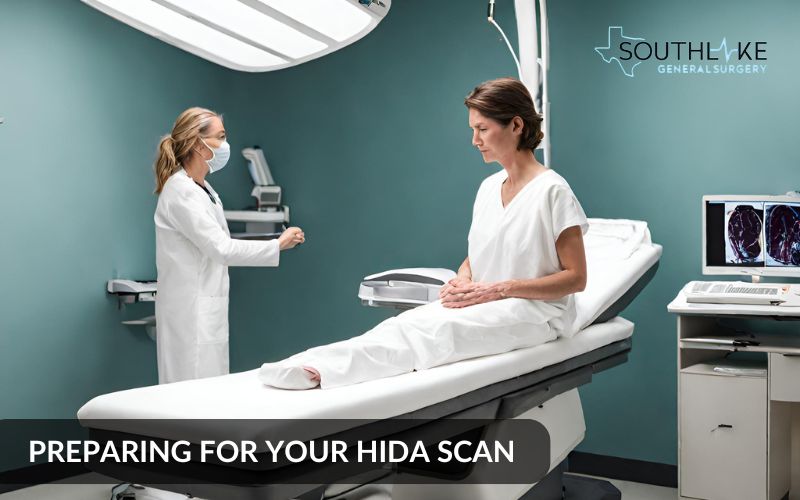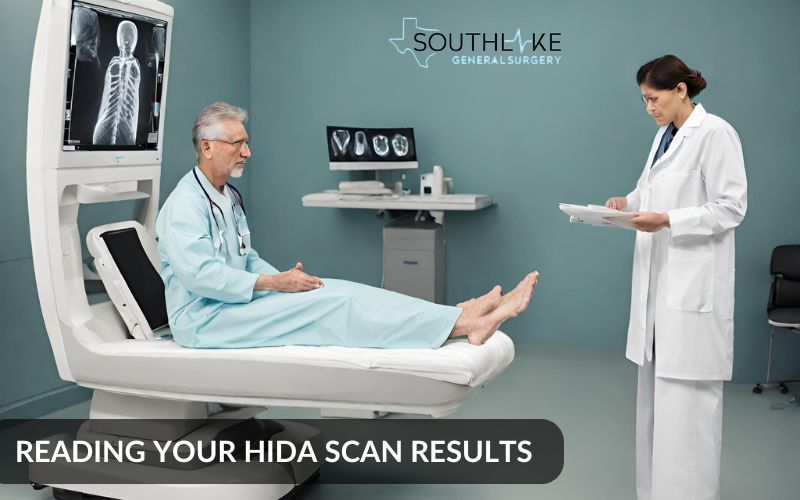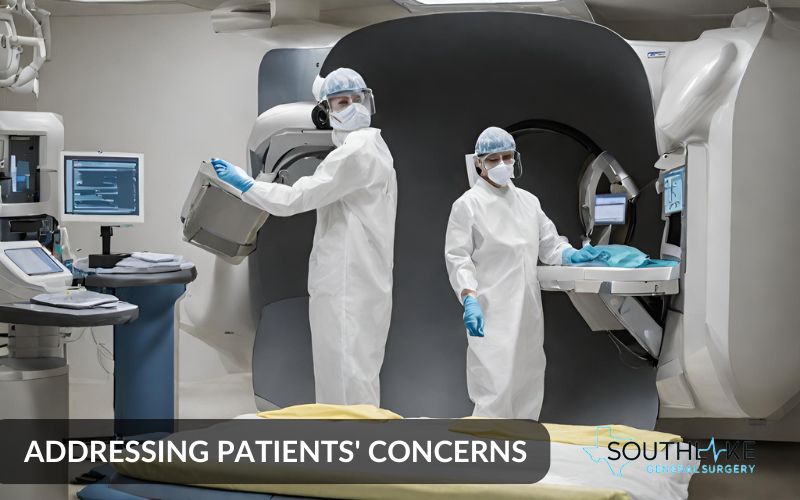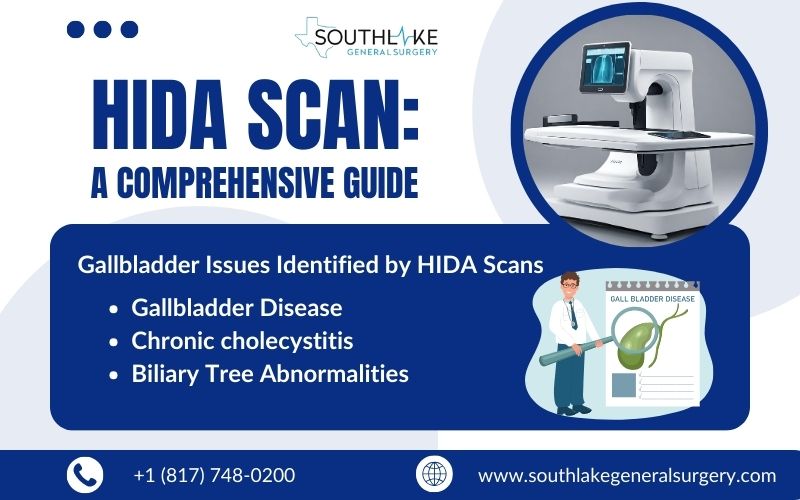The liver, bile ducts, and gallbladder play vital roles in the digestive process. When these organs are not functioning properly, it can lead to various symptoms and conditions. One imaging procedure commonly used to diagnose and evaluate issues with these organs is a HIDA scan.
A HIDA scan, also called hepatobiliary scintigraphy or cholescintigraphy, is a non-invasive imaging procedure that monitors the movement of bile from the liver to the small intestine. It helps healthcare providers assess the function of the liver, bile ducts, and gallbladder to diagnose conditions such as acute cholecystitis, chronic cholecystitis, sphincter of Oddi dysfunction, biliary atresia, and biliary leak.
A radioactive tracer is injected into the bloodstream during a HIDA scan. The liver absorbs the tracer and then releases it into the gallbladder and small intestine. A gamma camera detects the energy emitted by the tracer and creates detailed images that show the flow of bile through the biliary system.
HIDA scans are performed in the Department of Nuclear Medicine in Radiology. They are commonly used alongside other imaging tests, such as X-rays and ultrasounds, to provide a comprehensive evaluation of the liver, bile ducts, and gallbladder.
In this comprehensive guide, we will provide a detailed understanding of HIDA scans, their importance in diagnosing gallbladder issues, how they work from a surgeon’s perspective, preparation for the scan, what to expect during and after the procedure, and potential findings and next steps. We will also address common concerns, risks, and considerations associated with HIDA scans.
Key Highlights
- A HIDA scan is an imaging procedure that tracks the flow of bile from the liver to the small intestine, helping to diagnose gallbladder issues.
- It is used to evaluate conditions such as acute cholecystitis, chronic cholecystitis, sphincter of Oddi dysfunction, biliary atresia, and biliary leak.
- The scan involves injecting a radioactive tracer into the bloodstream, where it is absorbed by the liver and later released into the gallbladder and small intestine.
- Preparation for a HIDA scan requires fasting for a specific period and informing your healthcare provider about any medications you are taking.
- During the scan, a gamma camera captures images of the tracer as it moves through the biliary system, allowing healthcare providers to assess its function.
- After the scan, you can go about your day as usual, and the remaining radioactive tracer will be eliminated from your body within a day or two.
Understanding HIDA Scans
A HIDA scan, also referred to as hepatobiliary scintigraphy, is a medical imaging technique that monitors the movement of bile from the liver to the small intestine. It uses a radioactive tracer, usually hepatobiliary iminodiacetic acid (HIDA), which is injected into the bloodstream.
The tracer is taken up by the liver cells and released into the bile ducts. It then flows through the gallbladder and into the small intestine. During the scan, a gamma camera detects the radioactive energy emitted by the tracer and creates images that show the function of the liver, bile ducts, and gallbladder.
Significance of HIDA Scans in Identifying Gallbladder Problems
HIDA scans play a crucial role in diagnosing and evaluating gallbladder issues. They are particularly important in diagnosing conditions such as acute cholecystitis, which is a sudden inflammation of the gallbladder that can be caused by gallstones. Acute cholecystitis often requires gallbladder surgery to alleviate symptoms and prevent complications.
By tracking the flow of bile through the biliary system, HIDA scans can help healthcare providers identify any obstructions or abnormalities in the gallbladder or bile ducts. This information is vital in determining the appropriate treatment plan, whether it involves surgical intervention, medication, or monitoring.
HIDA scans provide valuable insights into the function and health of the gallbladder, allowing healthcare providers to make accurate diagnoses and provide timely treatment for patients with gallbladder issues.
How HIDA Scans Work: A Surgeon’s Perspective
From a surgeon’s perspective, a HIDA scan provides valuable information about the function of the gallbladder and the flow of bile. One essential parameter that can be measured during a HIDA scan is the gallbladder ejection fraction. This refers to the percentage of bile that is released from the gallbladder when it contracts.
During the scan, a radioactive tracer is injected into the bloodstream, and as it moves through the liver, bile ducts, and gallbladder, a series of images are taken using a gamma camera. These images help surgeons assess the flow of bile from the liver to the gallbladder and ultimately to the small intestine.
By analyzing these images, surgeons can determine if there are any abnormalities or blockages in the bile ducts or gallbladder. This information is crucial in guiding treatment decisions and determining whether surgery or other interventions are necessary to address the underlying issue.
HIDA scans provide valuable insights into the function of the biliary system, allowing surgeons to make informed decisions and provide optimal care for their patients.
Preparing for Your HIDA Scan

Before undergoing a HIDA scan, there are certain preparations you need to follow to ensure accurate results. Your healthcare provider will provide you with specific instructions, but here are some general guidelines to keep in mind:
- Inform your healthcare provider about any medications you are taking, as some medications may interfere with the accuracy of the scan.
- Fasting for a minimum of four hours before the scan is necessary, which involves refraining from consuming any food or beverages except water.
- Remove any jewelry or accessories that may interfere with the scan, and wear comfortable clothing.
By following these preparations, you can help ensure a smooth and successful HIDA scan procedure. It is essential to communicate openly with your healthcare provider and ask any questions you may have before the scan.
Steps to Prepare for a HIDA Scan: Tips from Dr. Valeria Simone MD
Preparing for a HIDA scan is relatively straightforward, but there are a few important steps to keep in mind. Dr. Valeria Simone MD, shares some tips to help you navigate the preparation process:
- Follow the instructions provided by your healthcare provider regarding fasting. Usually, you will need to avoid food and drink for at least four hours before the scan, although specific requirements may vary.
- Inform your healthcare provider about any medications you are taking, as they may need to be adjusted or temporarily discontinued.
- Dress comfortably and remove any jewelry or accessories that might interfere with the scan.
- During the scan, you may experience slight discomfort from the injection of the radioactive tracer while lying still on the scanning table. Nevertheless, this discomfort is usually slight and short-lived.
- Rest assured that the amount of radiation exposure during a HIDA scan is considered safe and within acceptable limits.
By following these steps and staying informed, you can prepare for your HIDA scan with confidence and ensure accurate results.
Eating and Drinking: What You Need to Know Before Your Scan
One of the key preparations for a HIDA scan is fasting. Fasting is typically required for at least four hours before the scan to ensure accurate results. It is important to follow these fasting guidelines to avoid interference with the scan.
During the fasting period, you should refrain from consuming any food or drink, except water. It is essential to drink enough water to stay hydrated, but avoid consuming anything else, including juice, coffee, or tea.
Fasting helps ensure that the radioactive tracer used during the scan is not influenced by the digestion process, allowing for clearer and more accurate imaging of the biliary system.
If you have any concerns or questions about fasting before your HIDA scan, it is important to discuss them with your healthcare provider. They can provide specific instructions based on your circumstances and help alleviate any concerns you may have.
During the HIDA Scan
During a HIDA scan, you will be positioned on a scanning table, and a gamma camera will be used to capture images of the radioactive tracer as it moves through your biliary system. It is essential to stay still during the scan to achieve clear and accurate images.
The scan usually takes about an hour, during which you may be asked to change positions or hold your breath briefly. The healthcare team will provide instructions and guide you through the process to ensure optimal imaging.
If you experience any discomfort or have any questions or concerns during the scan, do not hesitate to communicate with the healthcare team. They are there to support you and ensure your comfort throughout the procedure.
What to Expect During the Procedure
During a HIDA scan, you can expect a non-invasive imaging test that tracks the flow of bile through your biliary system. The process generally includes these steps:
- You will be positioned on a scanning table.
- A gamma camera, which is a specialized imaging device, will be placed over your abdomen.
- The healthcare team will inject a radioactive tracer into your bloodstream. This tracer is taken up by the liver and released into the gallbladder and small intestine.
- The gamma camera will capture a series of images as the radioactive tracer moves through your biliary system.
- It is crucial to remain still during the procedure to ensure clear and accurate images.
The healthcare team will guide you throughout the procedure and provide any necessary instructions. The entire process usually takes about an hour, after which you can resume your regular activities.
Understanding the Role of the Radiologist and Surgeon During Your Scan
During a HIDA scan, both the radiologist and surgeon play important roles in interpreting the images and assessing the function of the biliary system.
The radiologist is responsible for analyzing the images captured by the gamma camera. They will interpret the flow of the radioactive tracer and assess how well bile is flowing from the liver to the gallbladder and small intestine. Based on their findings, they can identify any abnormalities or obstructions in the biliary system.
The surgeon, on the other hand, relies on the information provided by the radiologist to guide treatment decisions. The images from the HIDA scan help the surgeon determine the appropriate course of action, whether it involves surgical intervention or other treatment options.
By working together, the radiologist and surgeon ensure that patients receive accurate diagnoses and the most appropriate care for their biliary system issues.
After the HIDA Scan
After a HIDA scan, there are a few important steps to follow to ensure optimal recovery and to allow the remaining radioactive tracer to be eliminated from your body.
- Drink plenty of fluids, particularly water, to help flush the tracer out of your system.
- Use the restroom frequently to eliminate any radioactive tracer that may have been excreted in your urine or stool.
- Remember to wash your hands properly after using the bathroom.
- Resume your normal activities and diet unless otherwise instructed by your healthcare provider.
It is important to note that the amount of radiation exposure during a HIDA scan is minimal and poses no significant risk to your health or the health of those around you.
Immediate Steps Post-Scan: A Guide
After your HIDA scan, you can take some immediate steps to ensure comfort and well-being. Here is a guide to help you through the post-scan period:
- Slowly get up from the scanning table to avoid dizziness or light-headedness.
- Drink plenty of fluids, particularly water, to help flush the remaining radioactive tracer out of your system.
- Be aware of any signs of redness, swelling, or pain at the injection site. If you notice any of these signs, inform your healthcare provider.
- Resume your regular activities and diet, unless otherwise instructed by your healthcare provider.
- Wash your hands thoroughly after using the restroom to eliminate any traces of the tracer.
By following these steps, you can ensure a smooth recovery after your HIDA scan and minimize any potential discomfort or concern.
Reading Your HIDA Scan Results: Dr. Simone’s Insights

Interpreting the results of a HIDA scan requires expertise and experience, and provides valuable insights into understanding the scan results:
- The scan image will show the flow of the radioactive tracer through your biliary system.
- The overall quality of the scan, including the clarity and consistency of the images, is crucial in assessing the function of the biliary system.
- Any abnormalities or obstructions in the flow of bile can indicate issues such as gallbladder inflammation or other conditions affecting the biliary system.
Your healthcare provider will provide you with a comprehensive interpretation of the images and explain the implications for your health. By understanding the scan results, you can make informed decisions about your treatment and care.
Potential Findings and Next Steps
During a HIDA scan, various findings can be identified, providing valuable information about the function of the biliary system. Some potential findings include:
- Normal flow of bile, indicating healthy biliary function.
- Slow movement of the radioactive tracer, suggesting a possible blockage or obstruction.
- No tracer was seen in the gallbladder, indicating acute inflammation of the gallbladder.
- Abnormally low gallbladder ejection fraction, which may indicate chronic inflammation.
Based on the scan findings, your healthcare provider will determine the next steps in your treatment plan. This may involve further imaging, additional tests, or consultation with a specialist.
Common Gallbladder Issues Identified by HIDA Scans
HIDA scans are particularly useful in identifying and evaluating common gallbladder issues. Some of these issues include:
- Gallbladder disease: This term encompasses a range of conditions that affect the gallbladder, such as gallstones, inflammation, or infection.
- Chronic cholecystitis: This refers to repeated episodes of gallbladder inflammation, often caused by gallstones blocking the cystic duct intermittently.
- Biliary tree abnormalities: HIDA scans can detect obstructions or abnormalities in the bile ducts, which make up the biliary tree.
By identifying these issues through HIDA scans, healthcare providers can develop appropriate treatment plans tailored to each patient’s specific condition and needs.
When Surgery Is Recommended: Navigating Your Options in Texas
In some cases, surgery may be recommended based on the findings of a HIDA scan. Gallbladder surgery, also known as cholecystectomy, is a common procedure used to remove the gallbladder in cases of severe gallbladder disease or chronic cholecystitis.
In more complex cases, a liver transplant may be necessary to address issues with the biliary system. This procedure involves replacing a diseased liver with a healthy liver from a donor.
The decision to undergo surgery depends on various factors, including the severity of the condition, the patient’s overall health, and the gallbladder ejection fraction measured during the HIDA scan.
It is important to consult with a healthcare provider who specializes in hepatobiliary surgery to discuss your options and make an informed decision.
Risks and Considerations
As with any medical procedure, there are some risks and considerations associated with HIDA scans. It is essential to be aware of these potential risks and discuss them with your healthcare provider. Some of the key considerations include:
- Allergic reactions to medications containing radioactive tracers used during the scan, although they are rare.
- Bruising at the injection site of the radioactive tracer.
- Minimal radiation exposure, which is within safe limits.
- Precautions for pregnant individuals, as nuclear medicine tests are generally not performed during pregnancy due to potential harm to the developing fetus.
By understanding these risks and addressing any concerns with your healthcare provider, you can make informed decisions regarding your medical care.
Understanding the Risks Associated with HIDA Scans
HIDA scans are generally considered safe with minimal risks. However, it is important to be aware of potential risks associated with the procedure. These risks may include:
- Allergic reactions: Although rare, some individuals may experience allergic reactions to the radioactive tracer. It is important to inform your healthcare provider of any known allergies before the scan.
- Bruising: Bruising at the injection site of the tracer is possible, but it is typically minimal.
- Radiation exposure: HIDA scans involve the use of a small amount of radiation, but the exposure is within safe limits and not considered a significant risk.
Your healthcare provider will assess the potential risks and benefits of a HIDA scan based on your situation. They will provide guidance and address any concerns you may have before proceeding with the procedure.
Addressing Patients’ Concerns: Safety Measures in Place

Patient safety is a top priority during HIDA scans, and various safety measures are in place to minimize risks. These measures include:
- Proper handling and disposal of radioactive material: Healthcare providers follow strict protocols to ensure the safe handling and disposal of radioactive tracers used during the scan.
- Protection for nursing mothers: If you are breastfeeding, it is important to inform your healthcare provider, as precautions may need to be taken to prevent radioactive material from contaminating breast milk. Your healthcare provider will guide you through alternative feeding options during the period immediately following the scan.
By adhering to these safety measures, healthcare providers can minimize any potential risks associated with HIDA scans and ensure the well-being of their patients.
A Note From Southlake General Surgery
At Southlake General Surgery, we understand the importance of accurate diagnosis and individualized treatment for gallbladder issues. Our team of experienced surgeons and healthcare professionals provides comprehensive care and utilizes advanced imaging techniques, such as HIDA scans.
By combining expertise with state-of-the-art technology, we strive to deliver exceptional patient care and achieve the best possible outcomes. If you have any concerns or questions about HIDA scans or gallbladder issues, we are here to help. Get in touch with us to schedule an appointment and talk about your requirements.
Conclusion
HIDA scans are invaluable in diagnosing gallbladder issues, offering crucial insights into your health. From preparation tips to understanding the procedure and post-scan steps, this comprehensive guide equips you with knowledge for a smoother experience.
Knowing what to expect during and after the scan helps alleviate concerns and ensures efficient communication with healthcare providers. If you require further guidance or have specific questions, don’t hesitate to reach out to schedule an appointment. Your health is a priority, and being well-informed is the first step towards proactive healthcare management.
Make An Appointment
If you are experiencing symptoms related to your gallbladder or have concerns about your biliary system, it is important to seek medical advice and schedule an appointment with our healthcare expert at +1 (817) 748-0200. They can evaluate your symptoms, discuss your medical history, and recommend appropriate diagnostic tests, including HIDA scans.
Remember, early diagnosis and timely intervention are key to effective treatment and better outcomes for gallbladder issues.
Frequently Asked Questions
Can I Eat Before a HIDA Scan?
It is important to fast for at least four hours before a HIDA scan to ensure accurate results. This means refraining from eating any food, but you can drink water during the fasting period. Following these instructions will help ensure the effectiveness of the scan.
How Long Does a HIDA Scan Take?
A HIDA scan typically takes about an hour to complete. However, in some cases, additional imaging may be required within 24 hours of the initial scan. Your healthcare provider will provide specific instructions regarding the duration of the scan and any additional imaging that may be necessary.
What Are the Signs of Gallstones or Gallbladder Problems?
Signs of gallstones or gallbladder problems may include pain or discomfort in the upper belly or right side, particularly after eating a meal. Additional symptoms might involve feelings of nausea, vomiting, and fever. If you experience these symptoms, it is important to consult with your healthcare provider for an accurate diagnosis and appropriate treatment.
What Happens If My HIDA Scan Shows a Problem?
If your HIDA scan shows a problem with your gallbladder or biliary system, your healthcare provider will discuss the findings with you and recommend appropriate treatment options. Treatment may involve medication, lifestyle changes, or, in some cases, surgery to address the underlying issue. It is important to consult with your healthcare provider to determine the most appropriate course of action based on your condition.
Medically Reviewed By: Dr. Valeria Simone MD
Board-certified General Surgeon at Southlake General Surgery, Texas, USA.
Follow us on Facebook and YouTube.
References:
- Snyder, E., Kashyap, S., & Lopez, P. P. (2023, July 24). Hepatobiliary Iminodiacetic Acid Scan. StatPearls – NCBI Bookshelf. https://www.ncbi.nlm.nih.gov/books/NBK539781/
- Goussous, N., Maqsood, H., Spiegler, E., Kowdley, G. C., & Cunningham, S. C. (2017, April 1). HIDA scan for functional gallbladder disorder: ensure that you know how the scan was done. Hepatobiliary & Pancreatic Diseases International. https://doi.org/10.1016/s1499-3872(16)60188-1
- Goussous, N., Maqsood, H., Spiegler, E., Kowdley, G. C., & Cunningham, S. C. (2017, April 1). HIDA scan for functional gallbladder disorder: ensure that you know how the scan was done. Hepatobiliary & Pancreatic Diseases International. https://doi.org/10.1016/s1499-3872(16)60188-1
- Johnson H Jr, Cooper B. The value of HIDA scans in the initial evaluation of patients for cholecystitis. J Natl Med Assoc. 1995;87(1):27-32.

